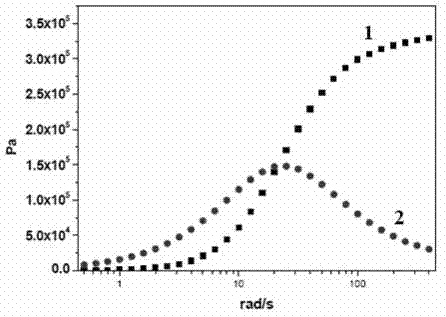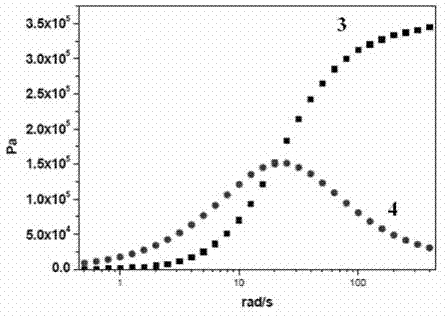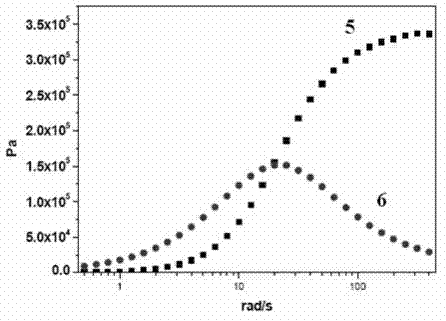Preparation method of intelligent stress response material
A smart material and stress technology, applied in the field of materials, can solve the problems of poor stress response ability, low energy absorption rate, no self-healing performance, etc., and achieve the effect of good energy absorption rate and good stress response ability.
- Summary
- Abstract
- Description
- Claims
- Application Information
AI Technical Summary
Problems solved by technology
Method used
Image
Examples
preparation example Construction
[0033] The invention provides a method for preparing a stress-responsive smart material, comprising the following steps:
[0034] A) Mix polydiorganosiloxane, boron-containing compound, bifunctional chain extender and functional modifier, react and dry to obtain a stress-responsive smart material precursor;
[0035] B) Post-processing the precursor of the stress-responsive smart material to obtain a stress-responsive smart material;
[0036] The post-treatment is one or more of heating, microwave radiation, mixing with a dispersant and then removing the dispersant, extrusion and rolling.
[0037] In the invention, polydiorganosiloxane, boron-containing compound, bifunctional chain extender and functional modifier are firstly mixed, reacted, and dried to obtain a stress-responsive intelligent material precursor.
[0038] The polydiorganosiloxane is dihydroxyl-terminated polydimethylsiloxane, and the molecular weight of the polydiorganosiloxane in the present invention is prefe...
Embodiment 1
[0070] 25 g of cyclohexyl ethylene borate and 75 g of polydimethylsiloxane with a molecular weight of 4000 were evenly mixed and stirred at 110° C. for 4 hours to obtain a first reaction liquid.
[0071] 5 g of bifunctional chain extender hexamethyl diisocyanate was added to the first reaction liquid, and the reaction was continued with stirring for 2 hours at a reaction temperature of 40° C. to obtain a second reaction liquid.
[0072] 3 g of functional modifier tetraisobutyl titanate was added to the second reaction liquid, and stirred and reacted at 70° C. for 8 hours to obtain a primary reaction product of nanoscale stress-responsive intelligent material.
[0073] Drying the primary reaction product of the nanoscale stress-responsive smart material at 70° C. for 24 hours can obtain a precursor of the stress-responsive smart material.
[0074] The stress-responsive smart material precursor was heated at 140° C. for 2 hours to obtain a stress-responsive smart material.
[0...
Embodiment 2
[0093] 15 g of tricresyl borate and 85 g of polydimethylsiloxane with a molecular weight of 6000 were evenly mixed and stirred at 90° C. for 3 hours to obtain a first reaction liquid.
[0094] 6 g of bifunctional chain extender hexamethyl diisocyanate was added to the first reaction liquid, and the reaction was continued with stirring for 6 hours at a reaction temperature of 60° C. to obtain a second reaction liquid.
[0095] To the second reaction liquid, 3 g of the functional modifier tetraisobutyl titanate was added to the first reaction liquid, and stirred and reacted at 70° C. for 8 hours to obtain the primary reaction product of the nanoscale stress-responsive smart material.
[0096] The primary reaction product of the nanoscale stress-responsive smart material was dried at 60° C. for 20 hours to obtain a precursor of the stress-responsive smart material.
[0097] The stress-responsive smart material precursor was heated at 180° C. for 0.5 hour to obtain a stress-respon...
PUM
| Property | Measurement | Unit |
|---|---|---|
| molecular weight | aaaaa | aaaaa |
| viscosity | aaaaa | aaaaa |
| particle diameter | aaaaa | aaaaa |
Abstract
Description
Claims
Application Information
 Login to View More
Login to View More - R&D
- Intellectual Property
- Life Sciences
- Materials
- Tech Scout
- Unparalleled Data Quality
- Higher Quality Content
- 60% Fewer Hallucinations
Browse by: Latest US Patents, China's latest patents, Technical Efficacy Thesaurus, Application Domain, Technology Topic, Popular Technical Reports.
© 2025 PatSnap. All rights reserved.Legal|Privacy policy|Modern Slavery Act Transparency Statement|Sitemap|About US| Contact US: help@patsnap.com



